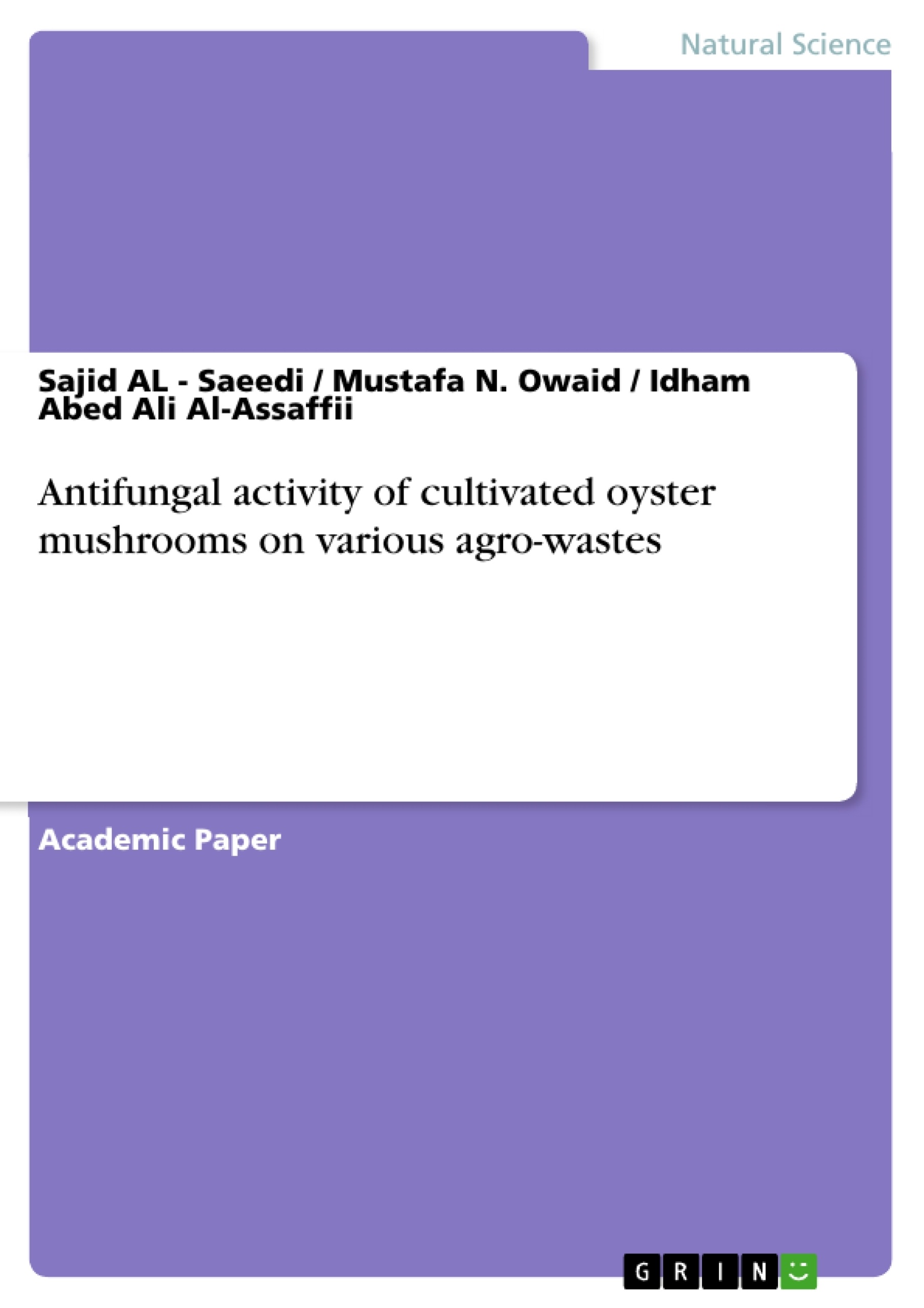The oyster mushroom, Pleurotus spp., is edible. About seventy species of Pleurotus spp. have been recorded. Many oyster mushrooms are primary decomposers of hardwood trees found worldwide. Thus, it can be cultivated on a wide variety of substrates containing lignin, cellulose and hemicellulose. It must obtain nutrients from such organic sources as dead organisms since they had absorbed nutrients after digesting large molecules into smaller units because of their secreted enzymes; thus, it has been grown in Iraq on various agro-wastes in the wild, or manually on cardboard, date palm wastes, and tree sawdust.
Since ancient times, macrofungi have been used as a valuable food source and as traditional medicines around the world. The fungi constitute an important source for some compounds including enzymes and antibiotics. Consequently, the antimicrobial activity of various polysaccharides from medicinal mushrooms is being reevaluated in relation to their clinical efficacy, given that such compounds would be expected to function to ward off bacterial and fungal infections resistant to current antibiotics. Medicinal mushrooms are able to synthesize a great amount of secondary metabolites that present anti-tumoral, antiviral, anti-inflammatory, antibacterial, antifungal and anti-yeast activities.
This study evaluated the antifungal activity of four fruiting bodies of oyster mushroom harvested from three agro-substrates in vitro.
Inhaltsverzeichnis (Table of Contents)
- I. INTRODUCTION
- II. MATERIAL AND METHODS
- A. Strains
- B. Media and Liquid Culture Filtrate Preparation
- C. Bioactivity of Filtrate of Oyster Mushrooms
- D. Bioactivity of Mycelia of Oyster Mushrooms
- E. Statistical Analysis
- III. RESULTS
- A. Microbial Growth in Liquid Culture Filtrates of Pleurotus spp.
- B. Interaction Between Mycelia of Pleurotus spp. and Colonies of Pathogenic Bacteria
- IV. DISCUSSION
Zielsetzung und Themenschwerpunkte (Objectives and Key Themes)
This research paper investigates the antimicrobial activity of four oyster mushroom species (Pleurotus spp.) against pathogenic bacteria and yeast, both in the form of liquid filtrates and mycelia.
- Antimicrobial activity of oyster mushroom species
- Comparison of antimicrobial activity between liquid filtrates and mycelia
- Influence of different Pleurotus spp. strains on antimicrobial efficacy
- Potential applications of oyster mushrooms in combating microbial infections
- Impact of secondary metabolism on antimicrobial activity
Zusammenfassung der Kapitel (Chapter Summaries)
- Introduction: The study introduces the potential of oyster mushrooms (Pleurotus spp.) as a source of antimicrobial compounds. It highlights the nutritional and medicinal properties of these mushrooms and emphasizes the importance of investigating their antimicrobial activity against pathogenic bacteria and yeast.
- Material and Methods: This section details the experimental design, including the strains of oyster mushrooms and pathogenic microbes used, the preparation of liquid culture filtrates, and the methods employed to assess the antimicrobial activity. The authors describe the techniques used to determine the inhibition zones and optical density measurements.
- Results: This chapter presents the findings of the study, focusing on the antimicrobial activity of the liquid filtrates and mycelia against different bacteria and yeast. Specific data on inhibition percentages and optical density values are provided.
- Discussion: The authors analyze the results, interpreting the differences in antimicrobial activity among the various strains of oyster mushrooms. They delve into the possible mechanisms behind the antimicrobial effects, such as the role of secondary metabolites, and discuss the limitations of the study, such as the impact of heat sterilization on bioactivity.
Schlüsselwörter (Keywords)
The research focuses on the antimicrobial activity of Pleurotus spp., examining the effects of both liquid filtrates and mycelia on pathogenic bacteria and yeast. The study explores the importance of secondary metabolism and its impact on the bioactivity of these mushrooms. Key concepts include in vitro antimicrobial activity, fungal secondary metabolites, and the potential of oyster mushrooms for medicinal applications.
- Citar trabajo
- Sajid AL - Saeedi (Autor), Mustafa N. Owaid (Autor), Idham Abed Ali Al-Assaffii (Autor), 2016, Antifungal activity of cultivated oyster mushrooms on various agro-wastes, Múnich, GRIN Verlag, https://www.grin.com/document/417172




